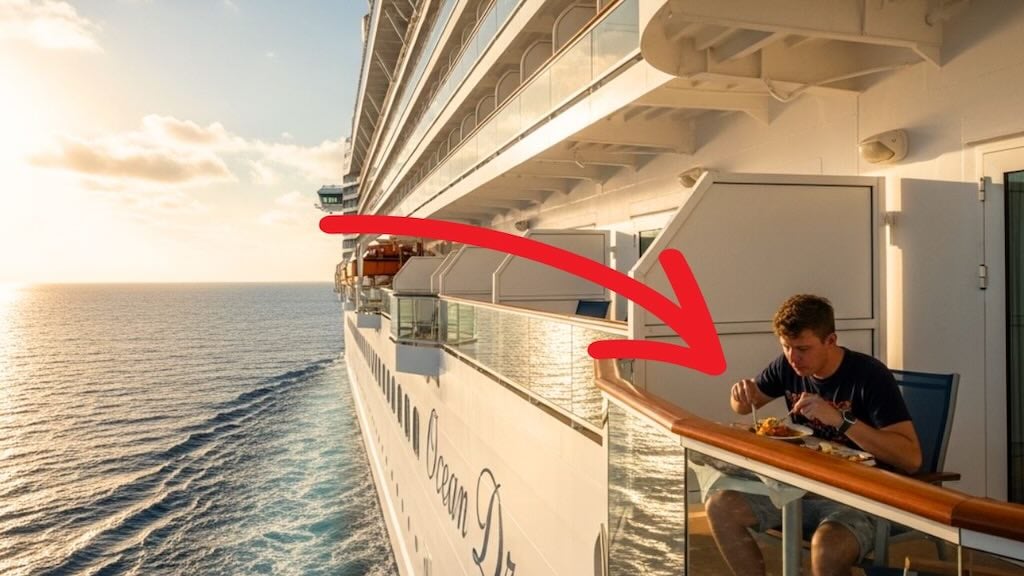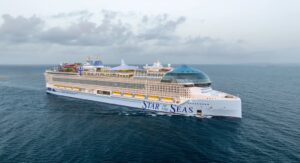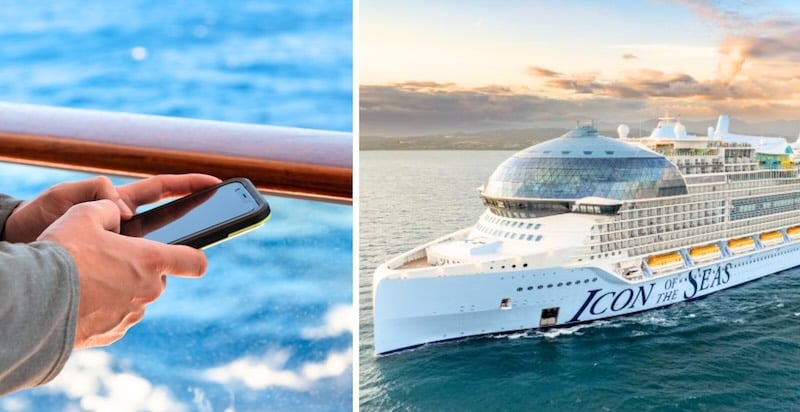When people picture the largest ship in the world, two names always come to mind: Titanic and Icon of the Seas. One was a symbol of early 1900s luxury, a ship so famous that its story is still told more than 100 years later. The other is Royal Caribbean’s brand-new mega ship, a floating city that has shattered every record in modern cruising.
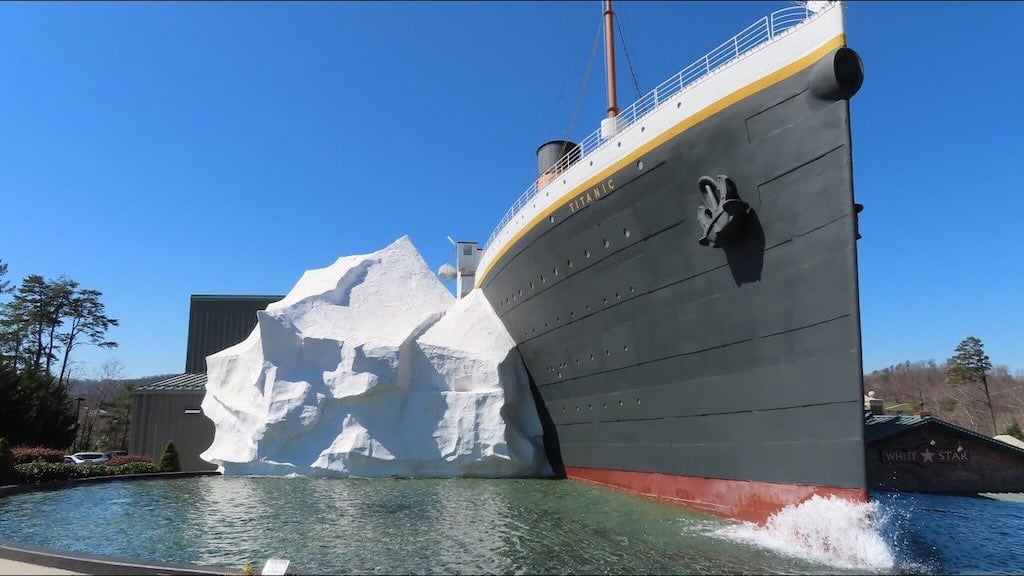
But in a head-to-head matchup of Icon of the Seas vs Titanic, the differences are nothing short of staggering.
Icon of the Seas vs Titanic
Icon of the Seas vs Titanic is the ultimate cruise ship comparison — the most legendary ocean liner of all time stacked up against today’s largest cruise ship ever built.
When Titanic set sail in 1912, it was celebrated as the pinnacle of human engineering and elegance. At 46,000 gross tons and nearly 900 feet long, it was hailed as the biggest moving object in the world. Fast forward to 2024, and Royal Caribbean’s Icon of the Seas dwarfs it in every category: 250,800 gross tons, 20 decks, and room for nearly 10,000 people onboard.
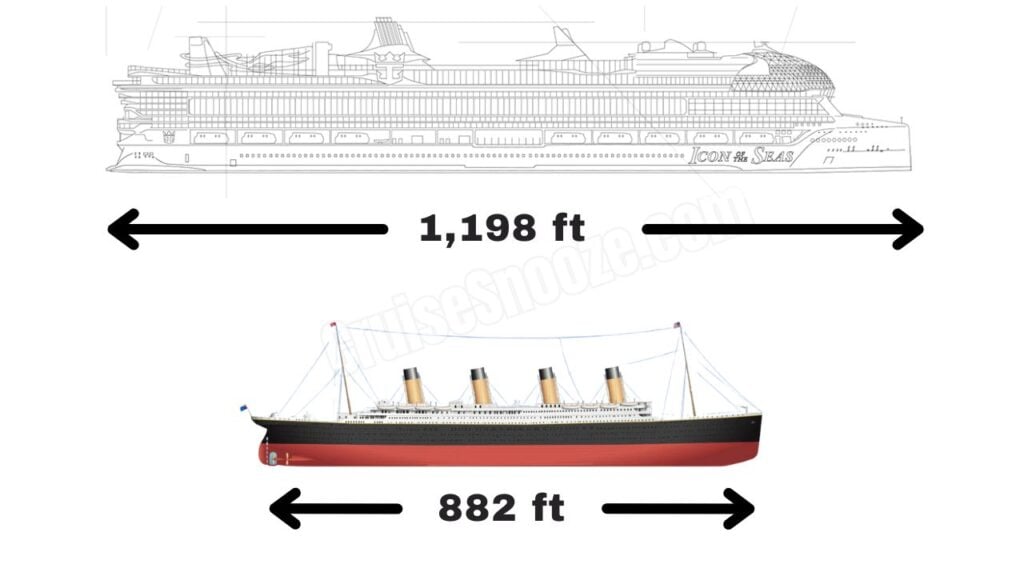
In this guide, we’ll break down the jaw-dropping differences between these two ships — from size and safety to dining, entertainment, and even ticket prices. Along the way, we’ll link to other helpful resources like our Titanic vs Modern Cruise Ships pillar post and comparisons such as Symphony of the Seas vs Titanic.
By the end, you’ll see just how far cruising has evolved in the past century — and why Titanic will always remain a legend, even as Icon of the Seas redefines the future.
Icon of the Seas vs Titanic – Size
When it comes to Icon of the Seas vs Titanic, the first thing everyone wants to know is just how much bigger the modern ship really is. Spoiler alert: the difference is jaw-dropping.
In 1912, Titanic was considered the largest moving object ever built. At 46,328 gross tons, stretching 882 feet long and just over 92 feet wide, it was the pride of the White Star Line. Crowds gathered at Southampton just to marvel at its sheer size.
But fast forward to today, and Icon of the Seas makes Titanic look almost… small. Royal Caribbean’s newest giant measures in at a staggering 250,800 gross tons, 1,198 feet long, and 213 feet wide — nearly 5.5 times the volume of Titanic. Even its height is nearly double, with 20 decks towering above the waves compared to Titanic’s 10.
Here’s a quick side-by-side:
| Ship | Gross Tonnage | Length | Width | Decks |
|---|---|---|---|---|
| Titanic (1912) | 46,328 GT | 882 ft | 92 ft | 10 |
| Icon of the Seas (2024) | 250,800 GT | 1,198 ft | 213 ft | 20 |
To put it in perspective: if Titanic pulled up next to Icon in Miami, it would look like a little sibling. In fact, even Titanic’s iconic four funnels would barely rise above Icon’s upper decks.
If you’re fascinated by these size battles, check out our full breakdown of Star of the Seas vs Titanic and see how Royal Caribbean’s other mega ship stacks up.
Icon of the Seas vs Titanic – Passenger Capacity and Crew
Size is one thing, but what really matters at sea is how many people a ship can carry — and here’s where the gap between Icon of the Seas vs Titanic gets even wider.
When Titanic sailed in 1912, it could carry about 2,435 passengers and 892 crew members, bringing the total to just over 3,300 people at full capacity. For its time, this was enormous, and the ship’s class system strictly separated passengers by wealth and social standing.
Now compare that to Icon of the Seas: this ship can hold a jaw-dropping 7,600 passengers at maximum occupancy, with an additional 2,350 crew to keep everything running smoothly. That’s nearly 10,000 people on a single sailing — more than three times Titanic’s total.
| Ship | Passenger Capacity | Crew | Total Onboard |
|---|---|---|---|
| Titanic (1912) | 2,435 | 892 | ~3,327 |
| Icon of the Seas (2024) | 7,600 | 2,350 | ~9,950 |
Think about that for a second. Icon carries almost as many crew members as Titanic carried passengers. And with today’s focus on service, dining, and entertainment, the staff-to-guest ratio is far more comfortable than the rigid, class-divided world of Titanic.
Want to see another staggering stat? Our guide to Harmony of the Seas vs Titanic shows just how quickly cruise ships grew in the decades after Titanic’s sinking.
Icon of the Seas vs Titanic – Safety Then vs Now
The tragedy of Titanic is what forever etched its name into history. Despite being hailed as “unsinkable”, the ship went down on its maiden voyage in April 1912 after striking an iceberg, claiming over 1,500 lives. The disaster changed maritime law forever — and the differences in safety compared to modern cruise ships like Icon of the Seas are massive.
Titanic’s Safety in 1912:
- Only 20 lifeboats, enough for about half of those onboard
- No mandatory lifeboat drills for passengers
- Relied on human lookouts instead of radar or sonar
- Compartments that weren’t fully watertight
- Poor communication technology (wireless radio with limited range)
Icon of the Seas’ Safety Today:
- Enough lifeboat capacity for every passenger and crew member (required by law)
- Mandatory muster drills before sailing
- Advanced radar, sonar, and GPS systems to detect hazards long before they become a threat
- Double-hull design and fully watertight compartments
- Real-time satellite communications for immediate contact with rescue agencies
The entire modern framework for maritime safety — known as SOLAS (Safety of Life at Sea) — exists because of Titanic. Today’s ships, including Icon, are designed not just to avoid disasters, but to safely evacuate everyone onboard if something unthinkable were to happen.
It’s safe to say that if Titanic had the technology and regulations of today, its story would have been very different. For more on the lessons learned from that night, check out our guide to Where the Titanic Sank.
Icon of the Seas vs Titanic – Cabins and Comfort Levels
If there’s one area where you can truly see how cruising has transformed, it’s in the cabins. The difference between Titanic’s Edwardian-era staterooms and Icon of the Seas’ modern accommodations is like stepping from a Victorian mansion into a luxury resort.
Titanic’s Cabins (1912):
- First Class: Lavish suites with ornate woodwork, fireplaces, and private promenades. The most expensive “Parlour Suites” were among the finest rooms ever built at sea.
- Second Class: Comfortable but modest cabins, with small sitting areas and shared bathrooms.
- Third Class (Steerage): Basic bunk-style rooms, sometimes sleeping up to 10 people in one cabin, with communal washrooms. Many immigrants endured these cramped spaces on their way to America.
Icon of the Seas Cabins (2024):
- Over 2,800 staterooms across more than 40 categories, from budget-friendly interior rooms to multi-story luxury residences.
- Every cabin includes private bathrooms, climate control, and modern tech conveniences.
- The Ultimate Family Townhouse is a three-story suite with a wraparound balcony, its own slide, and even a private mailbox.
- Unlike Titanic, all passengers on Icon have access to nearly every venue onboard, regardless of cabin type.
| Ship | Cabin Highlights |
|---|---|
| Titanic | Class-based separation, shared bathrooms, only top suites had true luxury |
| Icon of the Seas | Variety for all budgets, private bathrooms in every room, massive themed suites |
The bottom line? Titanic reflected the rigid class system of its era, while Icon of the Seas reflects the modern idea of vacation: comfort and options for every traveler.
For another jaw-dropping contrast, see how today’s cabins stack up in our Symphony of the Seas vs Titanic comparison.
Icon of the Seas vs Titanic – Dining and Food
Food has always been a big part of cruising, but the scale and variety between Titanic and Icon of the Seas couldn’t be more different.
Dining on Titanic (1912):
- First Class: Multi-course fine dining in the opulent Dining Saloon, plus access to the exclusive À la Carte Restaurant and Café Parisien. Menus featured lobster, filet mignon, oysters, and French wines.
- Second Class: Respectable meals like roast meats and hearty soups, served in their own dedicated dining room.
- Third Class: Simple cafeteria-style fare — stews, porridge, bread, and tea — eaten in communal spaces. Still, Titanic’s steerage meals were better than many passengers had ever experienced at home.
Dining on Icon of the Seas (2024):
- More than 20 dining options, from buffets to specialty restaurants, offering cuisine from sushi and Italian to steakhouses and seafood.
- Multiple free venues, meaning even budget-conscious cruisers can enjoy variety without spending extra.
- Casual bites at spots like El Loco Fresh for tacos or Sorrento’s Pizza, alongside premium experiences like Chops Grille and Izumi.
- Dozens of bars and lounges, including themed concepts like the Lime & Coconut.
| Ship | Dining Highlights |
|---|---|
| Titanic | Strictly divided by class, limited venues, menus reflected social status |
| Icon of the Seas | Dozens of dining choices, global cuisine, all passengers enjoy wide variety |
Here’s the kicker: Titanic had four restaurants in total, while Icon has more than four times that number just in the Royal Promenade. Dining has gone from a formal necessity to a vacation highlight.
For a deeper look at Titanic’s cultural legacy, check out our roundup of 10 Best Titanic Museums in the World — many even display recreated menus from the ship’s final night.
Icon of the Seas vs Titanic – Entertainment and Activities
This is where the difference between Titanic and Icon of the Seas really jumps off the page. Back in 1912, leisure at sea was a far more restrained affair. Today, cruising is about non-stop fun from morning till midnight.
Entertainment on Titanic (1912):
- A squash court, gymnasium, and Turkish baths for First Class passengers.
- Deck games like shuffleboard and quoits.
- Live music from the ship’s band, which famously played as the ship sank.
- Libraries, smoking lounges, and card games for those looking to socialize.
- Third Class passengers had very limited entertainment options — mostly music and small gatherings.
Entertainment on Icon of the Seas (2024):
- Six record-breaking waterslides at Thrill Island, including the first open free-fall slide at sea.
- The AquaDome with high-diving performances and acrobatics.
- A full ice-skating rink, laser tag arena, mini-golf, and surf simulators.
- Broadway-style shows, karaoke, live music venues, and comedy clubs.
- Eight themed “neighborhoods,” each designed with its own vibe — from family fun in Surfside to serene relaxation at the adults-only Hideaway.
| Ship | Entertainment Highlights |
|---|---|
| Titanic | Squash, gym, Turkish baths, live band, card games |
| Icon of the Seas | Waterslides, AquaDome, surfing, ice shows, themed neighborhoods, nonstop nightlife |
The contrast is so stark it almost feels unfair. Titanic’s entertainment was rooted in elegance and formality. Icon of the Seas is built to be a floating amusement park, where passengers can try something new every single day.
If you’re fascinated by just how modern ships became “floating cities,” you’ll love our Titanic vs Modern Cruise Ships deep dive, which explores this evolution in detail.
Icon of the Seas vs Titanic – Technology
The leap in maritime technology from 1912 to today is staggering. Titanic was state-of-the-art for its time, but compared to Icon of the Seas, it feels like comparing a typewriter to an iPhone.
Titanic’s Technology (1912):
- Powered by coal-fired steam engines with 29 boilers, producing a cruising speed of about 21 knots.
- Navigation relied on lookouts in the crow’s nest and basic compasses.
- Communication was handled via Marconi wireless radio, which had limited range and relied on Morse code.
- No air conditioning, and heating was centralized — cabins had little to no climate control.
- “Watertight” compartments that, as history proved, were not watertight enough.
Icon of the Seas’ Technology (2024):
- Powered by Liquefied Natural Gas (LNG), one of the cleanest-burning fuels for modern ships.
- Advanced radar, sonar, and GPS detect hazards miles away — icebergs wouldn’t stand a chance.
- High-speed satellite internet (Starlink) allows streaming, video calls, and real-time navigation updates.
- Dynamic positioning systems let the ship “park” without an anchor using GPS-guided thrusters.
- Full climate control in every cabin, plus innovations like air filtration and water recycling systems.
| Ship | Tech Highlights |
|---|---|
| Titanic | Coal engines, manual navigation, Morse code, no AC |
| Icon of the Seas | LNG engines, GPS, radar, Starlink internet, smart ship systems |
If Titanic represented the peak of industrial-age engineering, Icon of the Seas represents the digital age of cruising — where efficiency, sustainability, and passenger comfort drive design.
For more on how modern ships evolved, check out our guide to Will the Titanic Ever Be Brought to the Surface? — a fascinating look at technology’s limits even today.
Icon of the Seas vs Titanic – Cost of a Tickets
Cruising has always carried a price tag, but the difference between Titanic’s fares in 1912 and Icon of the Seas’ fares today shows just how much value has changed over time.
Titanic Ticket Prices (1912):
- Third Class: Around £7 ($35 at the time), equal to roughly $900 today. These cabins often had no windows and were shared with multiple passengers.
- Second Class: About £13 ($65 at the time), equal to roughly $2,000 today. Comfortable but modest rooms with access to dining and lounges.
- First Class: Anywhere from £30 to £870 ($150–$4,350 at the time). Adjusted for inflation, the most luxurious suites would cost more than $100,000 today. These included private promenade decks, sitting rooms, and ornate Edwardian décor.
Icon of the Seas Ticket Prices (2024–2025):
- Interior Cabins: Starting around $1,200 per person for a 7-night Caribbean cruise.
- Balcony Cabins: Around $2,000–$3,000 per person, depending on season and itinerary.
- Suites: Ranging from $5,000 up to $85,000+ for the Ultimate Family Townhouse during peak holiday weeks.
| Ship | Cheapest Ticket | Mid-Level | Most Expensive |
|---|---|---|---|
| Titanic (1912) | $900 (today’s value) | $2,000 (today’s value) | $104,000 (today’s value) |
| Icon of the Seas (2024) | $1,200 | $2,500 | $85,000 |
Here’s the kicker: while Titanic’s most luxurious suites cost more than even Icon’s priciest accommodations, modern cruising is far more accessible. Today, middle-class families can afford a vacation on Icon, while in 1912 most people couldn’t dream of affording First Class on Titanic.
For more context, see our full breakdown of Titanic vs Modern Cruise Ships — you’ll be shocked at how ticket pricing has shifted with time.
Icon of the Seas vs Titanic – Environmental Impact
When Titanic sailed in 1912, environmental concerns were virtually nonexistent. Ships were built for size, speed, and luxury — not sustainability. Today, modern cruise lines like Royal Caribbean face constant scrutiny over emissions, waste, and energy use, which is why Icon of the Seas represents a new era of eco-conscious cruising.
Titanic’s Environmental Footprint (1912):
- Powered by coal-fired steam engines, which produced massive amounts of smoke and soot.
- Burned more than 600 tons of coal per day, shoveled by hand by hundreds of stokers.
- No waste treatment systems — garbage and sewage were often discharged directly into the sea.
- Air and water pollution were considered the unavoidable byproducts of progress.
Icon of the Seas’ Environmental Features (2024):
- First Royal Caribbean ship powered by Liquefied Natural Gas (LNG), which cuts greenhouse gas emissions compared to traditional marine fuel.
- Advanced wastewater purification systems, ensuring nothing harmful goes untreated into the ocean.
- Air lubrication system to reduce drag and improve fuel efficiency.
- Energy-efficient LED lighting, smart HVAC systems, and solar panels help lower energy use.
- Built under Royal Caribbean’s “Destination Net Zero” commitment, aiming for net zero emissions by 2050.
| Ship | Fuel Source | Waste Management | Sustainability Focus |
|---|---|---|---|
| Titanic (1912) | Coal | None (dumped overboard) | Nonexistent |
| Icon of the Seas (2024) | LNG | Advanced treatment systems | Designed for efficiency & emissions reduction |
Put simply, Titanic was a product of the industrial revolution, while Icon of the Seas is a product of the sustainability revolution.
For more perspective on how far ships have come, check out our Star of the Seas vs Titanic comparison — another LNG-powered giant rewriting cruising’s environmental story.
Icon of the Seas vs Titanic – Legacy and Cultural Influence
Some ships fade into history, but Titanic and Icon of the Seas have both etched themselves into popular culture — just in very different ways.
Titanic’s Legacy (1912):
- Titanic’s sinking is still the most famous maritime disaster in history, with over 1,500 lives lost.
- Immortalized in books, documentaries, and the 1997 Titanic film, which grossed over $2 billion worldwide.
- The ship has become a symbol of both human ambition and human vulnerability.
Titanic museums and exhibitions around the world continue to draw millions of visitors each year, with Titanic Belfast in Northern Ireland widely regarded as the top experience. (see our full list of Best Titanic Museums).
Icon of the Seas’ Influence (2024):
- Launched as the world’s largest cruise ship, instantly dominating headlines across mainstream and travel media.
- Dubbed a “floating city,” Icon has become a marketing symbol for Royal Caribbean’s innovation and dominance in the cruise industry.
- Viral videos of its AquaDome shows, family neighborhoods, and record-breaking waterslides have exploded across social media.
- Represents cruising’s shift from simple transportation to destination-at-sea vacationing.
| Ship | Legacy |
|---|---|
| Titanic | Cultural icon, memorialized in film and history, symbol of tragedy |
| Icon of the Seas | Modern marvel, symbol of innovation and luxury, viral social media presence |
The difference is striking: Titanic became a legend because of its tragedy, while Icon of the Seas is becoming legendary because of its sheer scale and innovation. Both ships, in their own way, define an era of human achievement.
If you’re interested in how Titanic continues to inspire fascination today, don’t miss our article on Will the Titanic Ever Be Brought to the Surface?.
Icon of the Seas vs Titanic – Why This Comparison Matters Today
At first glance, comparing Icon of the Seas vs Titanic might feel like comparing two completely different worlds — and in many ways, it is. One was an ocean liner built for transatlantic travel, the other a cruise ship designed to be the vacation itself.
But the comparison matters because it shows just how far humanity has come in a little over a century:
- From coal smoke and telegrams to LNG fuel and Starlink internet
- From 20 lifeboats for half the ship to lifeboats and drills for every passenger onboard
- From cramped third-class bunks to multi-story luxury suites with slides and private balconies
- From a tragedy that shaped maritime law to a ship designed with sustainability at its core
Both ships captured the imagination of their eras. Titanic represented ambition, progress, and social divides of the early 1900s. Icon of the Seas represents innovation, entertainment, and accessibility in modern travel.
Looking at them side by side isn’t just trivia for cruise fans — it’s a reminder of how travel, technology, and safety evolve with each generation.
If this fascinates you, our deep dive into Titanic vs Modern Cruise Ships shows the full evolution from Titanic’s world to today’s mega ships.
Icon of the Seas vs Titanic – Jim’s Take
Whenever I dig into Icon of the Seas vs Titanic, I can’t help but shake my head at how far cruising has come. Titanic was the pride of her time — elegant, powerful, and unforgettable. But she was also a reminder of the limits of early technology and the cost of overlooking safety.
Icon of the Seas, on the other hand, feels like the opposite story. It’s a ship that exists because of Titanic’s lessons. Every lifeboat, safety drill, radar system, and double-hull design traces its roots back to what happened in 1912. Add in the waterparks, Broadway shows, and dining that spans every cuisine imaginable, and you realize this isn’t just transportation — it’s an entire vacation floating on the ocean.
So which ship is “better”? The truth is, both are icons. Titanic will always hold a place in history, while Icon of the Seas is making history right now. Together, they tell the story of how cruising evolved from a means of crossing the Atlantic to the kind of vacation people dream about all year long.
If you enjoyed this comparison, make sure to check out my Ultimate Cruise Packing List before your next sailing — because whether you’re stepping on a modern mega ship or just daydreaming about Titanic’s past, being prepared makes every cruise even better.



